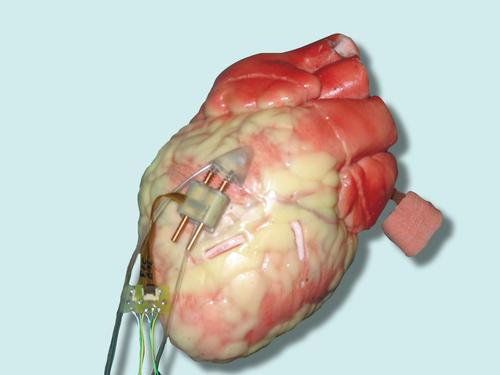Robotics is an ever-advancing and emerging filed of the new era. With robots in the health sector, healthcare professionals have been able to achieve otherwise unattainable targets or goals that were once too difficult to meet. One such breakthrough is the HeartLander, a mini crawling robot designed to access the regions of the heart that are either inaccessible or require extensive surgery with high morbidity and mortality rates.
HeartLander is a mini mobile heart bug that delivers therapies to the beating heart with minimum invasion.
The operating surgeon/physician has to make a small percutaneous incision below the xiphoid process of the sternum from where the HeartLander is inserted. Using vacuum pressure, it adheres to the beating heart’s epicardium, then semi-autonomously navigates to the desired region of the heart and administers the specific therapy. In other words, it provides precise and stable access to the beating heart.

How does the HeartLander reach a specific location?
HeartLander has wire-drive actuators and a tracking sensor that navigates it semi-autonomously to the specific locations at a speed of 4mm per second. The operator has a joystick to control the robot according to the graphical representation of the robot on the epicardial surface. The locomotion enables HeartLander to access the otherwise inaccessible or hardly accessible areas of the epicardium
HeartLander can be inserted on an outpatient basis! This procedure doesn’t require general anesthesia.
HeartLander has a working channel. Upon reaching the desired & targeted location, therapies can be administered and therapeutic devices can be applied to the heart, including ablation catheters for atrial fibrillation, injections, and pacing leads. When compared with the existing robotics in cardiac surgery, HeartLander improves accessibility, cardiac stabilization, and precision. It decreases the morbidity associated with access. Above all, it’s comparatively inexpensive, and it is disposable.
HeartLander was able to traverse the heart and reach the targeted locations autonomously when studied on beating porcine (pig) heart. Moreover, preclinical feasibility studies have demonstrated myocardial injection of dye, epicardial lead placement, and epicardial ventricular ablation from HeartLander.
References
HeartLander. (2019). Retrieved from The Robotics Institute Carnegie Mellon University: https://www.ri.cmu.edu/project/heartlander/
Patronik NA, Ota T, Zenati MA, Riviere CN. A Miniature Mobile Robot for Navigation and Positioning on the Beating Heart. IEEE Trans Robot. 2009;25(5):1109-1124. doi:10.1109/tro.2009.2027375
Chapman MP, Lopez Gonzalez JL, Goyette BE, et al. Application of the HeartLander crawling robot for injection of a thermally sensitive anti-remodeling agent for myocardial infarction therapy. Conf Proc IEEE Eng Med Biol Soc. 2010;2010:5428-5431. doi:10.1109/IEMBS.2010.5626518




